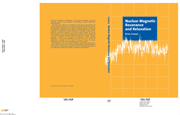Book contents
- Frontmatter
- Contents
- Preface
- 1 Introduction
- 2 Theoretical background
- 3 Detection methods
- 4 Classical view of relaxation
- 5 Quantum treatment of relaxation
- 6 Dipolar lineshape in solids
- 7 Relaxation in liquids
- 8 Some case studies
- 9 The density operator and applications
- 10 NMR imaging
- Appendix A Fourier analysis
- Appendix B Random functions
- Appendix C Interaction picture
- Appendix D Magnetic fields and canonical momentum
- Appendix E Alternative classical treatment of relaxation
- Appendix F Gm(t) for rotationally invariant systems
- Appendix G P(Ω, Ωo, t) for rotational diffusion
- Problems
- References
- Index
6 - Dipolar lineshape in solids
Published online by Cambridge University Press: 02 December 2009
- Frontmatter
- Contents
- Preface
- 1 Introduction
- 2 Theoretical background
- 3 Detection methods
- 4 Classical view of relaxation
- 5 Quantum treatment of relaxation
- 6 Dipolar lineshape in solids
- 7 Relaxation in liquids
- 8 Some case studies
- 9 The density operator and applications
- 10 NMR imaging
- Appendix A Fourier analysis
- Appendix B Random functions
- Appendix C Interaction picture
- Appendix D Magnetic fields and canonical momentum
- Appendix E Alternative classical treatment of relaxation
- Appendix F Gm(t) for rotationally invariant systems
- Appendix G P(Ω, Ωo, t) for rotational diffusion
- Problems
- References
- Index
Summary
Transverse relaxation: rigid lattice lineshape
Introduction
The calculation (or at least the attempt at calculation) of the dipolar-broadened NMR absorption lineshape in solids has been one of the classical problems in the theory of magnetic resonance. Of course, the lineshape is the Fourier transform of the free precession decay so that a calculation of one is equivalent, formally, to a calculation of the other.
The method for performing such calculations was pioneered by Waller in 1932 and Van Vleck in 1948. However, to the present date no fully satisfactory solution has been found, despite the vast number of publications on the subject and the variety of mathematical techniques used. Nor is there likely to be. General expressions for transverse relaxation were given in the previous chapter. Restriction to a rigid lattice solid: the absence of a motion Hamiltonian, results in a considerable simplification of the equations, as we shall see. Nevertheless it is still a many-body problem of considerable complexity.
The various attempts at solving the problem of the transverse relaxation profile in solids have usually been based on the use of certain approximation methods whose validity is justified a posteriori by the success (or otherwise) of their results. We shall be examining some of these; none is really satisfactory. Conversely, and it may come as a surprise to discover, the more complicated case of a fluid system often permits approximations to be made which are well justified and with such approximations the resulting equations may be solved. This will be treated in the following chapter, although we have had a foretaste of this in Chapter 4.
- Type
- Chapter
- Information
- Nuclear Magnetic Resonance and Relaxation , pp. 157 - 206Publisher: Cambridge University PressPrint publication year: 1997

